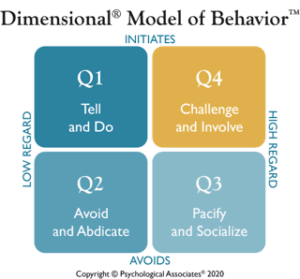Styles of Leadership Impact Success
What makes the difference between the leader who rises steadily through the ranks of an organization versus the derailed executive whose career mysteriously jumps the track, short of expectations? A study by Psychological Associates suggests that a major factor governing executive success is leadership style. A majority of the successful executives in the study exhibit similar behaviors characteristic of a collaborative style of leadership. In fact, our study indicates that collaborative leaders are twice as likely to be successful as those practicing other styles of leadership.
Research into Styles of Leadership
Sixty-seven top executives — vice-presidents and above — were evaluated for success on the job during the research. Each of the executives had been referred to Psychological Associates for training and consultation. Some were referred by their organizations because they were perceived to be successful managers who merely needed more development. Others were characterized as “derailed” managers whose future with the company was in doubt due to sub-par performance.
The data for the study was extracted from more than 550 multi-rater feedback documents. These documents were submitted by the 67 executives themselves, as well as by their bosses and their direct reports. Each participant was asked to rate the executive on specific management behaviors that make up leadership style: setting direction, delegating, decision making, communicating, and feedback. Subjects were also rated on their proficiency in basic management practices: controlling, leading, organizing, and planning.
A Two Horse Race?
Make no mistake. When measuring successful performance, the boss’s evaluation matters most; and productivity is an overriding concern of bosses. After all, managers are paid to get results. The study confirms that bosses prefer leaders who place an emphasis on productivity — in this case, the Q1 autocratic and Q4 collaborative leadership styles located above the horizontal line in the behavioral model, which indicates dominance or people who get the job done. On the other hand, submissive styles of leadership such as the Q2 uninvolved or the Q3 sociable styles do not get the job done.
What seems to be a two-horse race, however, takes an odd turn. When indicating the type of leader they find most effective, bosses, as well as all other participants in the study, chose the Q4 collaborative style of leadership overwhelmingly — two-to-one over the Q1 autocratic style. What’s more, despite a bias toward productivity, the Q1 autocratic leaders make up the majority of derailed executives in the study. Clearly, the preference is not simply a question of productivity.
When a worker is promoted into a management slot, that decision is most likely based on the person’s ability and success on the job. What many managers fail to understand is that effective leadership depends on the performance of other people. Derailed managers never fully realize that successful leadership rests on their ability to influence others to cooperate and participate.
Is Autocratic Leadership Effective?
This lack of insight seems evident when autocratic leaders assess their own performance. These derailed executives are perfectly happy performing in a Q1 manner. While they recognize that they are practicing an autocratic style of leadership, they see no reason to change. They fail to notice anything detrimental about their brand of behavior, even though their bosses and direct reports disagree.
Derailed managers operate under another misconception. They tend to overestimate their management abilities. While their bosses rated them average or above on management practices, the derailed executives consistently rated themselves significantly higher. It is important to emphasize that bosses appear to be satisfied with the derailed executives’ skill levels. This would seem to indicate that their dissatisfaction pertains to behavior. In other words, bosses aren’t unhappy with what these executives do, but rather with the way they do it. Effective leadership, then, is a matter of style.
Dimensional Model of Leadership Behavior
To simplify the concept of styles of leadership, we developed the Dimensional® Model™ of Leadership Behavior, which first appeared in our book, Improving Productivity Through People Skills. The Dimensional Model is Psychological Associates’ unique tool for observing, assessing, understanding, and sizing up the behavior of other people. The Model is formed by the intersection of two axes; the vertical axis is a continuum descending from the behaviors of Initiates to Avoids. The horizontal axis is a continuum spanning from the behaviors of Low Regard to High Regard. The Model is shown in the diagram.
 |
These four dimensions are defined as follows:
Initiates
Initiates means exercising control or influence — making things happen. People showing dominant behavior are forceful, dynamic, asserting themselves, trying to sway the way other people think or behave. They take charge, guide, lead, move other people to action.
Avoids
Avoids means being passive — letting things happen. People showing submissive behavior are willing to take a back seat — play follow-the-leader. They’re ready to comply, quick to give in, and reluctant to try exerting influence.
Low Regard
Low Regard is unresponsiveness— insensitivity to other people and their needs. People showing this behavior tend to care only about themselves, to lack regard for others’ feelings and ideas.
High Regard
High Regard is responsiveness — sensitivity to others and their needs. People showing high regard are open and caring. They have a high respect for other people’s ideas and feelings. That doesn’t mean they’ll gush over with affection; they can be warm without being openly affectionate.
Collaborative, Q4 Leaders Get the Best Results
As stated earlier, the Psychological Associates’ study reveals that most successful managers are Q4-style, or collaborative, leaders. It also shows that collaborative leaders are more highly skilled at management practices. They consistently show a greater capacity to look ahead, to set purpose and direction, to coordinate the activities of others, and to make sure everything stays on course (planning, leading, organizing, and controlling).
Mastery of the basics is only the beginning. Collaborative leaders are more greatly valued because they not only get things done, they do so in a manner that motivates the people around them. It’s their style of leadership that brings out the best performance in others. It’s their style that makes them successful. In leadership, style counts!
Download This Whitepaper
To download this whitepaper, please complete the form below and it will be emailed to you right away.













